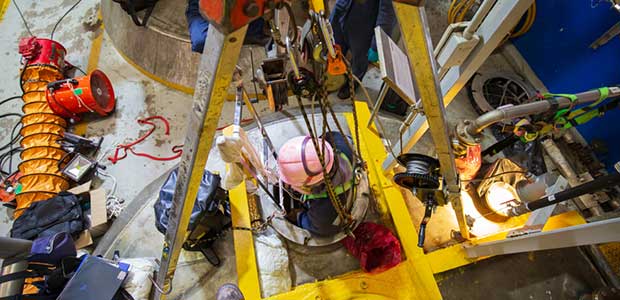
A Fall Protection Plan for Confined Space Rescues
How to prepare for and safely execute a confined space fall rescue.
- By David Ivey
- Mar 01, 2021
Fatalities caused by falls continue to be a leading cause of death for construction employees, and fall protection remains OSHA’s most frequently cited violation across all industries. The successful implementation of fall protection programs and use of PPE have had a huge impact on the number and severity of injuries and fatalities suffered by falling workers, but there is more work left to be done.
Fall protection systems are intended to arrest an uncontrolled fall and safely distribute the force on a fallen worker’s body. However, while the worker remains suspended in a fall protection harness awaiting rescue, his or her circulation is restricted, which can lead to a potentially life-threatening condition known as suspension trauma.
In a technical bulletin, OSHA states that suspension trauma can be fatal within 30 minutes. Dangerous effects of suspension trauma, however, can occur within as little as three to five minutes of a fall. Serious adverse health effects that require medical intervention can occur in as little as 12 to 15 minutes, according to an Air Force study.
Confined spaces introduce an additional wrinkle to your rescue efforts. A fall that occurs while a worker is in a confined space such as a sewer, well, tank or underground pipe or tunnel, limits rescuers’ options for reaching and recovering the suspended worker. When rescuers are on a short clock and every second matters, it pays to be prepared for a confined space rescue.
Creating a Rescue Plan
OSHA requires that employers’ fall protection plans include plans for a prompt rescue. Having a written rescue plan in place before an emergency strikes removes the confusion and disorganization that can add precious seconds and minutes to your response time. A rescue plan provides workers with the knowledge and procedures they need to follow in the event of an emergency to prevent injury or death.
A rescue plan includes a quick sheet that lists emergency contacts and a detailed response checklist for your team to use in case of a fall incident. A complete rescue plan document should also include fall rescue awareness resources for your team, as well as instructions for reporting fall incidents to OSHA.
Being prepared with a well-thought-out rescue plan is a good idea under any circumstances, but is especially important when faced with a confined space rescue. There are many free resources to help you create a rescue plan that is appropriate for your workplace and the kinds of situations your team is likely to encounter. You can find everything from basic confined space rescue checklists to fully customizable rescue plan templates online.
Use Equipment Designed for Confined Space Rescue
Tripods offer the flexibility of portable overhead tie-off atop confined-space entry points such as manholes, wells or tanks. Tripods can be used with optional winches to provide safe access and emergency rescue in confined spaces. Tripods accommodate a variety of fall arrest devices and winches.
A standard material/manhandling winch is designed for personnel riding, material handling, rescue and evacuation. You can also use a specialized three-way rescue winch with bi-directional winching that allows an attendant to safely raise or lower a worker in a confined space.
Personal fall arrest systems should be used in conjunction with these winches, regardless of type, and should be set up to limit the potential free fall to six feet. Fall protection PPE—such as full body harnesses, lanyards or self-retracting lifelines (SRLs)—should always be worn and properly tied off to an overhead anchor point such as a tripod.
Have a Trained Rescuer on Site
Having a capable rescuer in a position to help when the need arises is arguably the most important part of any rescue. Whenever someone is working in a confined space, have a partner in the vicinity who can come to the worker’s aid immediately in the event of an emergency.
This form of rescue goes by many names: Buddy Rescue, Companion Rescue or Assisted Rescue. In many cases, a single trained person can raise a fallen worker to safety immediately using a winch and the shoulder rescue handles on many harnesses. Having this rescuer in position before a fall in a confined space occurs means an immediate rescue without having to scramble to get a qualified person to the scene who then has to figure out how to reach the fall victim.
The rescuer should be trained in fall protection and rescue procedures, be familiar with your rescue plan and know how to operate the winch or SRL to retrieve a fallen worker. Rescue should only be performed by an authorized rescuer, meaning the employee should be trained in rescue procedures and equipment, as well as first-aid techniques associated with fall arrest incidents. Many suppliers of personal fall protection equipment and fall protection systems offer specialized training designed to educate workers on how to correctly use their products, so ask your supplier about these training opportunities when you purchase fall protection equipment.
When it comes to fall rescue, speed is of the essence. Minutes matter. A rapid rescue is essential for preventing secondary injuries—and even death—that can occur in a fall incident due to suspension trauma.
Having a rescue plan in place, equipping teams with appropriate PPE and equipment that enables confined space rescue and ensuring a capable rescuer is available to execute the rapid recovery of a fall victim are simple steps you can take to ensure your workers go home safe at the end of the day.
This article originally appeared in the March 2021 issue of Occupational Health & Safety.